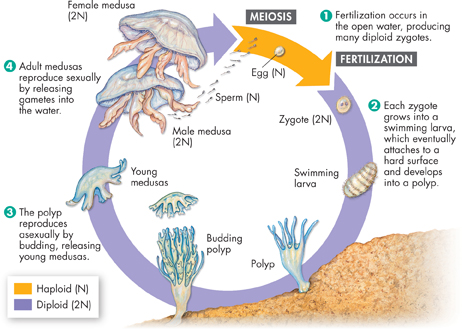
FIGURE 28–16 Alternating Reproductive Cycles The reproductive cycle of Aurelia, a jellyfish, alternates between asexual and sexual reproduction. A zygote is produced sexually by medusas and grows into a larva. The larva develops into a polyp that buds, reproducing asexually. The polyp releases a medusa.
ddInternal and External Fertilization
 How do internal and external fertilization differ?
How do internal and external fertilization differ?
In sexual reproduction, eggs and sperm meet either inside or outside the body of the egg-producing individual. These alternatives are called internal and external fertilization, respectively.
Internal Fertilization Many aquatic animals and nearly all terrestrial animals reproduce by internal fertilization.  During internal fertilization, eggs are fertilized inside the body of the egg-producing individual.
During internal fertilization, eggs are fertilized inside the body of the egg-producing individual.
▸ Invertebrates Invertebrates that reproduce by internal fertilization range in complexity from sponges to arachnids. The eggs of sponges and some other aquatic animals are fertilized by sperm released by others of their species and taken in from the surrounding water. In many arthropod species, males deposit sperm inside the female's body during mating.
▸ Chordates Some fishes and amphibians, and all reptiles, birds, and mammals, reproduce by internal fertilization. In some amphibian species, males deposit “sperm packets” into the surrounding environment; females then pick up these packets and take them inside their bodies. In many other chordate species, males have an external sexual organ that deposits sperm inside the female during mating.
MYSTERY CLUE

None of the females in the tank had had contact with a male for three years, long before they were mature enough to reproduce. And female bonnetheads had never been known to store sperm for longer than five months. So what happened?
Table of Contents
- Formulas and Equations
- Applying Formulas and Equations
- Mean, Median, and Mode
- Estimation
- Using Measurements in Calculations
- Effects of Measurement Errors
- Accuracy
- Precision
- Comparing Accuracy and Precision
- Significant Figures
- Calculating With Significant Figures
- Scientific Notation
- Calculating With Scientific Notation
- Dimensional Analysis
- Applying Dimensional Analysis




